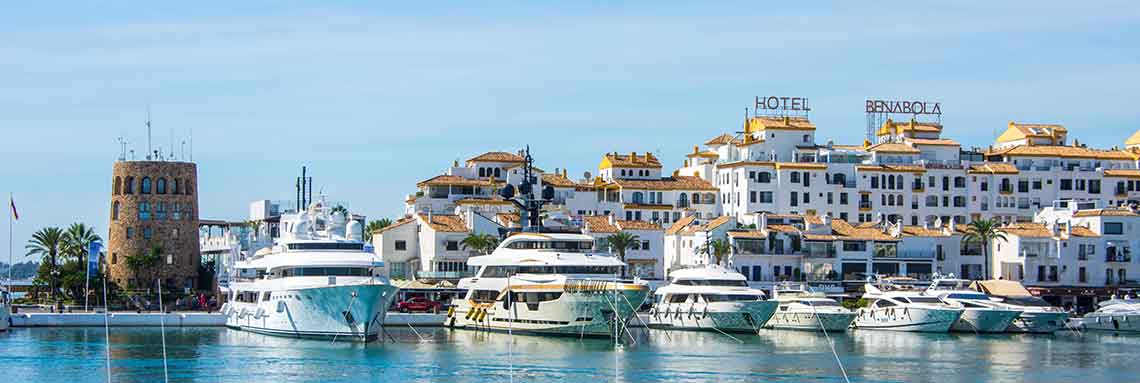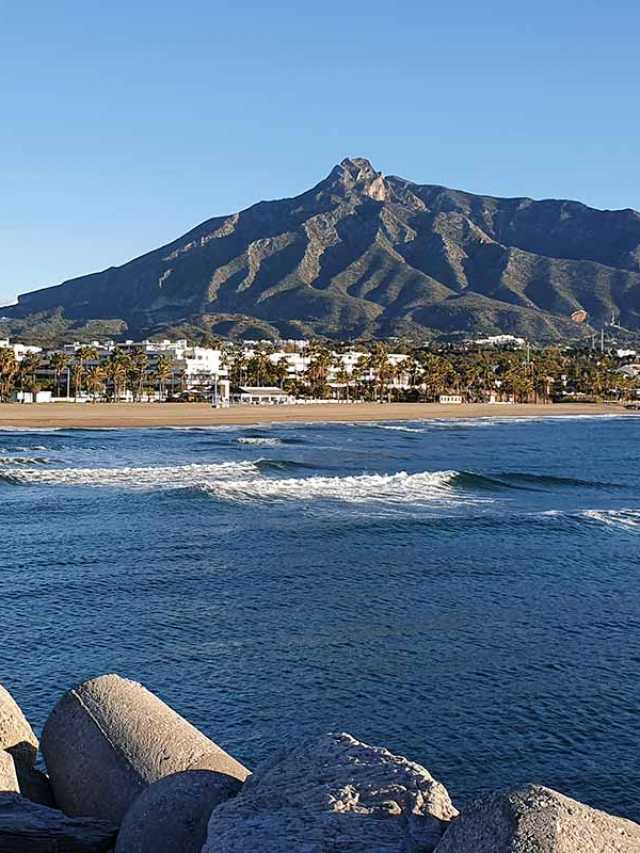

Plan your vacation with confidence, knowing what to expect from the weather in this beautiful coastal city. Stay informed about temperature trends, rainfall, sunshine hours, and more. Whether you’re seeking a sunny beach day or planning outdoor activities, our Marbella weather page has all the information you need to make the most of your time in this Mediterranean paradise.
Marbella is a popular resort town located on the southern coast of Spain, specifically in the province of Malaga, along the Costa del Sol. The town is known for its Mediterranean climate, which is characterized by mild, wet winters and hot, dry summers.
Summers in Marbella are hot and dry. Average daytime temperatures during this period typically range from 25°C to 30°C (77°F to 86°F), but temperatures can occasionally exceed 35°C (95°F) during heatwaves. The skies are mostly clear, and rainfall is minimal.
Autumn is a pleasant time to visit Marbella as the temperatures begin to cool down. September and October still offer warm weather with average highs between 23°C and 28°C (73°F to 82°F). November sees a further drop in temperature, with highs averaging around 18°C (64°F). Rainfall increases compared to summer but is still relatively low.
Marbella's winters are mild and can be quite wet. Daytime temperatures range from 15°C to 18°C (59°F to 64°F), and nighttime temperatures rarely drop below 10°C (50°F). Rainfall is more frequent during these months, and there might be occasional cloudy or overcast days.
Spring is a pleasant time to visit Marbella as the weather starts to warm up again. Temperatures rise gradually, with highs ranging from 18°C to 23°C (64°F to 73°F) in March and reaching 20°C to 25°C (68°F to 77°F) in May. Rainfall decreases compared to the winter months, and the town starts to bloom with greenery and flowers.
Marbella features a subtropical Mediterranean climate (classified as Köppen: Csa), characterized by humid and relatively mild winters by European standards, as well as warm to hot and dry summers. Shielded by the coastal mountains of the Cordillera Penibética to the north, Marbella benefits from a climate that maintains an average yearly temperature ranging from 18 to 19 °C (64 to 66 °F). Throughout the winter months, the highest peaks of the nearby mountain range occasionally don a snowy cover, a spectacle visible from Marbella's coastline, particularly when the Sierra Blanca mountain peak, reaching an altitude of 1,275 m (4,183 ft), experiences snowfall. The area experiences an average annual rainfall of 645.8 mm (25.43 in), coupled with an abundance of sunlight, with an average exceeding 2,900 hours annually.

In the backdrop stands the Sierra Blanca, while the Dunes of Artola grace the foreground, a true visual contrast. Marbella's topography can be categorized into five distinct geomorphological units: the Sierra Blanca, the foothills of Sierra Blanca (Sierra Blanca piedmont), the undulating lower hill country, the expansive plains, and the inviting coastal dunes.
At the heart of the province lies the Sierra Blanca, a commanding mountain range that presides over the historic village. This range features three prominent peaks: La Concha, situated to the west at an elevation of 1,215 m (3,986 feet) above sea level; Juanar Cross, positioned to the east (within the municipality of Ojen) at 1,178 m (3,865 feet) above sea level; and the loftiest summit, Mount Lastonar, found between the two at a height of 1,270 m (4,170 feet). The tapestry of Marbella's landscape is woven from the fabric of eroded mountains, giving rise to expansive coastal plains.
To the north of these plains, elevations oscillate between 100 and 400 m (330 and 1,300 feet), forming a landscape adorned with gentle hills. These hills eventually give way to the foothills and more steeply inclined slopes of the mountains further inland. Along the coast, a sense of serenity prevails as the land gently meets the sea, giving rise to sandy beaches that stretch extensively towards the east, spanning the distance between the fishing port and Cabopino.
Despite the bustling urbanization that has embraced the coastline, a pocket of untouched nature endures in the form of the Artola Dunes (Dunas de Artola), a natural expanse of sandy formations nestled at the eastern extremity of the town.
Spanning a stretch of land measuring forty-four kilometers (27 miles), the Marbella municipality elegantly unfolds along the coastline of the Penibético region. Nestled within the protective embrace of the coastal mountain range, an ensemble encompassing the Bermeja, Palmitera, Royal, White, and Alpujata sub-ranges, Marbella boasts a unique geographical setting. This location results in a distinctive spatial arrangement: the city finds itself wedged between the northern and southern slopes of the mountains, affording panoramic vistas of both the sea and the rugged peaks from nearly every corner of the urban expanse.
The city's coastline has undergone extensive urban development, with most available land not devoted to golf courses transformed into cozy residential pockets. The harmonious interplay of sea and mountain influences Marbella's landscape, making it a captivating visual symphony.
Marbella's borders are defined by its neighboring municipalities. To the north, it shares boundaries with Istán and Ojén, while its northwest is demarcated by Benahavís. The western perimeter aligns with Estepona, and the northeastern boundary aligns with Mijas. Completing this picturesque tableau, the azure waters of the Mediterranean Sea grace its southern edge, encapsulating the essence of Marbella's geographical allure.
Keep in mind that weather can be unpredictable, and there can be variations from year to year. If you're planning a trip to Marbella, it's a good idea to check a reliable weather forecast closer to your travel dates for the most up-to-date information.